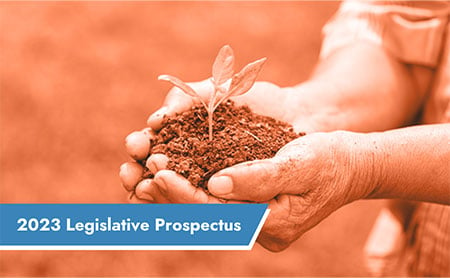Environmental Health: Impacts of Climate Change and Supporting Food Safety
December 12, 2022
Introduction
 Supporting healthy environments—including infrastructure promoting healthy choices where people live, work, and play—leads to better health outcomes for all people. Environmental health touches nearly every aspect of life, from ensuring clean air to breathe to clean water to drink to safe food to eat. Additionally, environmental health leaders work to mitigate threats posed by a changing climate—such as growing impacts of severe weather and increasing risk factors for disease vectors like ticks and mosquitoes. State and territorial legislatures can also play a crucial role in promoting environmental public health, from investing in climate resiliency to limiting industrial pollutants and risks
Supporting healthy environments—including infrastructure promoting healthy choices where people live, work, and play—leads to better health outcomes for all people. Environmental health touches nearly every aspect of life, from ensuring clean air to breathe to clean water to drink to safe food to eat. Additionally, environmental health leaders work to mitigate threats posed by a changing climate—such as growing impacts of severe weather and increasing risk factors for disease vectors like ticks and mosquitoes. State and territorial legislatures can also play a crucial role in promoting environmental public health, from investing in climate resiliency to limiting industrial pollutants and risks
to foodborne illness.
Legislative Trends
Climate Change Adaptation Planning
The effects of our changing climate, from rising temperatures to an increase in the occurrence and magnitude of extreme weather events, lead to negative health effects for individuals and communities. Public health impacts include increased instances of asthma, cardiovascular disease, and vector-borne diseases such as Lyme disease and Zika. WHO estimates that as many as 24.3% of deaths in 2016 were linked to the environment. In anticipation of these challenges, states and territories are developing climate adaptation plans tailored to the unique vulnerabilities their jurisdictions face, such as heightened risk of flooding or higher incidence of severe heat.
During the 2022 legislative sessions, at least three states (Maryland, Rhode Island, and Vermont) enacted legislation related to climate change or environmental justice. A new Maryland law established an Office of Resilience in the Maryland Department of Emergency Management, requiring the office to coordinate state and local efforts to build resilience to risks identified in the Maryland Hazard Mitigation Plan as well as develop a state resilience strategy. Rhode Island amended its executive climate change coordinating council advisory board membership to include one member of the public with expertise in environmental justice. Vermont enacted legislation establishing an environmental justice policy for the state and requiring state agencies to incorporate environmental justice into their work, rules, and procedures. It also established the Environmental Justice Advisory Council and the Interagency Environmental Justice Committee to advise the state on environmental justice issues, as well as requires the Agency of Natural Resources to create an environmental justice mapping tool.
Regulating PFAS
Per-and polyfluoroalkyl substances (PFAS) are synthetic chemicals used in products such as nonstick cookware, water-repellent clothing, stain-resistant fabrics, cosmetics, and firefighting foam. These chemicals can migrate into soil, water, and air during production and use, with most remaining in the environment without breaking down. Over time, PFAS can accumulate in the blood of people and animals from exposure to contaminated environmental media (e.g., water or soil) and consumer products (e.g., food packaged in containers made with PFAS). At least seven states (California, Colorado, Michigan, Ohio, Rhode Island, Vermont, and Washington state) enacted legislation limiting the use of PFAS in consumer product packaging, particularly for food and cosmetics. Rhode Island enacted legislation prohibiting the sale or promotional use of food packaging containing PFAS beginning in January 2024. Colorado’s new law prohibits the use of food packaging and cookware containing PFAS beginning in January 2024 and phases out the use of PFAS in other products, such as cosmetics and outdoor furnishings.
Food Safety
While several federal government agencies regulate commercial food products—such as through USDA meat processing inspections and FDA produce inspections—cottage foods (i.e., food products produced outside a commercial kitchen and sold to the public) are not subject to federal regulation since they are not typically sold across state lines. While the requirements are different for each state, typical cottage food regulations include the types of foods producers are allowed to sell and the way producers can sell and label them.
In 2022, cottage food legislation in many states focused on the types of foods allowable for sale. Illinois enacted legislation amending the types of foods permissible under the cottage food law from a delineated list of canned foods (e.g., jams and syrups) to a general standard of "low-acid canned food" to align with FDA’s definition. Tennessee and Oklahoma enacted “food freedom” laws, broadly expanding the types of homemade foods eligible for sale under their cottage food laws.
Looking Ahead
During the upcoming legislative session, ASTHO expects states and territories to consider bills that:
- Support comprehensive climate adaptation planning, including efforts to fortify infrastructure and support residents relocating after a natural disaster.
- Direct state agencies to establish drinking water regulations, such as creating maximum contaminant levels for specific PFAS.
Promote the decarbonization of health care and public health, such as directing hospitals to be more energy efficient and get to net zero carbon emissions. - Support a One Health approach that mutually benefits human, animal, and environmental health.